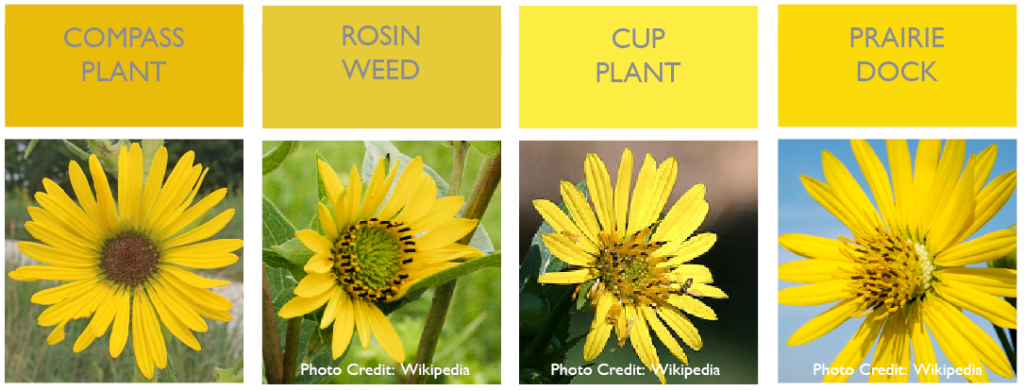Do you have an out-of-the-way plot of ground that needs to be vaccinated from the maladies of soil erosion or a lack of biological diversity? Is this planting area safely physically distanced from other more manicured areas of your landscape? Would you like 2020 to be remembered for something other than COVID-19? If you answered “yes” to any of these questions, I have a selection of very easy-to-grow native plant species that will establish your prairie landscape area faster than a coronavirus infects a church choir.
Brad’s PPE (Prairie Pandemic Elections)
Blooms May-June

- Illinois bundle-flower (Desmanthus illinoensis) – a nitrogen-fixing legume with seed heads that are as attractive as its flowers
- river oats (Chasmanthium latifolium) – the only shade-oriented species of the bunch that originates from stream corridors of Eastern Kansas
- beebalm (Monarda fistulosa) – the flowers attract bumblebees and the vegetation can be used make mint tea
- common milkweed (Asclepias syriaca) – this favorite host plant for the monarch butterfly also has very sweet aroma when flowering
- gray-headed coneflower (Ratibida pinnata) – stunning splashes of yellow when this species blooms in mass
Blooms July-August

- compass plant (Silphium laciniatum)
- rosin weed (Silphium integrifolium)
- cup plant (Silphium perfoliatum)
- prairie dock (Silphium terebinthinaceum)
The genus Silphium offers four very hearty species that have so much to offer. Learn more about these species from a previous blog post.
Blooms August-September

- western ironweed (Vernonia baldwinii) – this is the taller and more robust cousin of our plant sale favorite ‘iron butterflies’ ironweed
- tall joe-pye weed (Eupatorium altissimum) – few species will attract more pollinators than this Eupatorium
- brown-eyed susan (Rudbeckia triloba) – so beautiful and so invasive
- tall thistle (Cirsium altissimum) – not all thistles are bad as I discuss in an earlier blog post
- Canada goldenrod (Solidago canadensis) – goldenrods are famous for their color and pollinator attraction in late summer and few are heartier than this species
- Maximilian sunflower (Helianthus maximiliani) – learn more about this and other sunflower species that could be considered good pandemic picks in an earlier blog post
See an earlier post I wrote about these late summer blooming “undesirables” and all the loads of insects they attract to our Arboretum landscape.
Prairie Ecosystem vs Prairie Gardening
In a diverse and thriving prairie ecosystem where these native species typically reside, a dense matrix of competitive prairie grasses and grazing animals help keep them in check. You could say that the prairie plant community has a herd immunity against these aggressive, super-spreader species.
But when you plop these species into a nutrient-rich, urban prairie garden with mulch and plenty of moisture, they grow seemingly with reckless abandon. They don’t have the same competitive prairie environment or grazers regularly eating them back to keep them in check. They spread quickly with rapidly expanding root systems and prolific seed production. These pandemic picks are long-haulers that will quickly (within a five years) take over slower and lower growing species, and you won’t need contact tracing to know where they came from. Therefore, we’ve learned (the hard way from some of our thankfully forgiving members) that these pandemic picks with their tall, rank growth do not belong in a small, more manicured garden.
So, given this information, you may ask…why recommend these pandemic picks that would make one symptomatic of a foolish gardener? Or, to put it more bluntly, WHO in the world is this CDC (Center for Dumb Consultation) that is giving you this advice!? Dyck Arboretum, of course!
The species I’m recommending provide colorful, aesthetically-pleasing blooms, soil erosion control, interesting vegetation, host plant food for caterpillars, and loads of nectar for pollinators. These species are extremely drought tolerant and will survive fine without care from you. And as an added bonus, they provide hearty competition for and crowd out annual plants like giant ragweed, a pollen emitter that makes you want to don your N-95 mask this time of year!
The major disclaimer I will offer and the key to being happy with these pandemic picks in your landscape is choosing a remote place where they can all be quarantined together. The more physical distance you can give this cluster planting location, the less likely their seeds are to invade more manicured areas of your prairie landscape. The only care this planting needs is an annual mowing/cutting in winter or early spring. Add some flammable tall grasses to the mix like big bluestem, Indian grass, and switch grass, and you can burn it annually instead.
To learn more about these species, visit the Kansas Wildflowers and Grasses website. A handful of these species are available through our FloraKansas native plant sale. Zoom on over to Dyck Arboretum in the coming days of September 10 (for members) and September 11-13 (for general public). All of these species can be found on our grounds. Bring a paper bag, catch me at FloraKansas, and I’d be happy to show you where these species can be found and give you permission to collect seed.
Get in early on this pollinator-friendly planting trend now as it may soon go viral!
